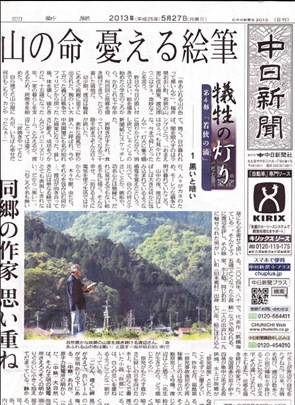 “Lively mountains are black,” said Sunao Watanabe, 81, an old painter in Wakasa (Fukui Prefecture). It might sound strange, but he has thought that for more than 70 years since he began painting when he was an elementary school child. He has depicted his home hundreds of times.
“Lively mountains are black,” said Sunao Watanabe, 81, an old painter in Wakasa (Fukui Prefecture). It might sound strange, but he has thought that for more than 70 years since he began painting when he was an elementary school child. He has depicted his home hundreds of times.
Watanabe was born into a destitute family and was fostered out to a carpenter in his childhood. His foster father came back alive from the battlefront in Philippines, but since then became bedridden. Watanabe became a charcoal burner when he was 15 years old to support his foster family. He built a coal pit in the mountain and cut oak trees and made them charcoals. When night fell, it was just a small lamp to illuminate the darkness. “I didn’t see you last night. Where have you been?” He talked to moths coming to the light and sketched them on rumpled newspaper with cinders.
He had lived that way until he became 30 years old when it was difficult to make a decent living as a charcoal burner. He is, however, now a well-known painter called “a poet in the mountain.” It sounds like a success story after suffering from poverty. But he says, “The happiest time of my life was when I was making charcoals…” That was an age of high economic growth when people were working like mad for money.
Watanabe sometimes had a special feeling as if he was surrounded by something huge at midnight in the mountain. Then he realized his tininess and just sketched without thinking anything. It was the happiest time for him. “You can’t understand that if you live by using a lot of electricity.” The mountains which Watanabe has faced cannot be described as just green. So, he says they are “black”.
“He cares pebbles and nameless weeds when he paints.” Tsutomu Mizukami, a novelist who passed away at the age of 85 in 2004, used to describe Watanabe that way. Mizukami and Watanabe were from the same village in Fukui. They met each other in 1970, when Mizukami, who had become a fan of Watanabe, visited the painter’s house. Since then Watanabe has illustrated Mizukami’s books. Painting and writing. Their means of expression were different, but both of them have depicted their hometown.
Their home has 14 nuclear power reactors, which is the most all over Japan. Mizukami had been anxious about that. The third and fourth reactors in Ohi Nuclear Power Station restarted last July for the first time after the disaster in Fukushima No.1 Nuclear Power Plant. Watanabe wondered what Mizukami would have said about that if he had been alive.
Mizukami kept suspicious eyes on prosperity brought by Ohi Nuclear Power Station. He expressed his thoughts in “Kokyo (hometown)”, one of his novels: Look, a cape far away and a white dome under the sunshine. (snip) That’s the light of the nuclear power plant. (snip) Nature is holding a product of modern civilization like a small candle light and is silent. The sea is very quiet.”
Watanabe understands Mizukami’s thoughts. “Nuclear power plants are made by human-being.” He cannot feel anything huge from the structures. He rarely paints the nuke plant. But lately he had to paint one because he was asked by an acquaintance. At that time he daubed the background with dark colors. It was not “black”. The surround of the powerhouse looks “dark” through his eyes.
(The Chunichi May 27, 2013, translated by Moshimshimo)